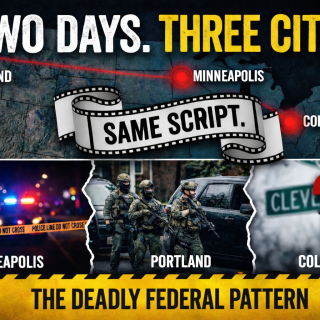Advertisement
Almost all visitors to Columbus comment with surprise about the city’s dirtiness, trash, broken streets and sidewalks, confusion about parking, and uncontrolled vehicular traffic including bicycles and especially electric scooters.
With no recognized identity or documented history, I dub Columbus, Ohio, the United States’ “plague city.” Knowledgeable residents may first think that I refer to the city’s nationally high rates of racially and economically-linked infant and maternal mortality, or police murders (with judicial and City impunity) of unarmed young Black men. Or the incomplete, unknowledgeable, and too brief responses to Covid and tardiness with the measles outbreak now.
But my identification pertains primarily to the city’s unsafe and unsanitary physical environment. We hear little to nothing from the “mayor” or our unrepresentative city councilors about this, despite its dramatic contradiction to their unusually poor and out-of-touch sloganeering. Of course, “contradiction” is not a concept with which they are familiar.
Across the city, unlike many other “we’re a big city now” cities, to quote more than one councilor, electric scooters unsafely litter the city, especially dramatically north of the privileged but undistinguished Short North. That area’s newly powerful developer elite is ethically at least, and probably legally uncomfortably close with City officials.
There is no pretense of the regulation that council legislative aides promised me twenty months ago when I personally provided them readily available information on the sensible regulation that “big cities” from Seattle and Portland to New York City, with many, including Detroit, in between. As in so much else, Columbus is exceptional but never in the ways of its unusually poor slogans.
In that period, conditions materially worsen. My University District neighborhood is literally littered with rental scooters left unattended on sidewalks and street corners, right side up, sideways, on the ground, illegally blocking sidewalk rights of way.
Beyond littered scooters blocking passage especially of the handicapped from the mobility limited, disabled, wheelchair bound, and those pushing strollers, carriages, or carts, scooters ridden carelessly without helmets and while listening to cellphones with ear- or headphones are dangerous. Accidents, often severe, are common. Risks rise with two persons riding together, rarely with helmets.
On a recently morning walk, I encountered more than 60 abandoned within twenty minutes. I often report them to 311. When they respond at all, I am told to contact the three largest rental companies. But how to do that and with what expectation, I am not told.
I have asked Refuse to pick them up as trash. They cannot. Zoning Enforcement refers me to Public (aka Private) Services whose commitment to “enhancing mobility” relentlessly reduces and restricts mobility. They have no knowledge of contradictions, truth and honesty, or public service. They refuse to answer any questions from either the public or, as far as I can tell, council legislative aides.
I discussed this with Columbus Police very recently. I called them in response to the eight young women OSU tenants who live across the street and delight in harassing—with the endorsement of their landlord who used to live in the house, and his debt collector “attorney”-- their senior citizen, retired professor neighbor whose assistance they welcomed last year, for daring to request respect for the law and other people. On this day, they laboriously moved their scooter well onto my property, trespassing, just as they demand that I do not walk illegally on their’s when I do not.
The police read the law to me: scooters should be left on right of ways—in other words sidewalks, for which the resident is primarily responsible—unless they interfere with “mobility.” When I asked the officers to explain to me how a scooter left on a sidewalk could possibly not interfere with human mobility, they were silent. Yet they alternatively restated that the police “hated” scooters but it “is legal to leave them on sidewalks.” I haven’t figured that out yet.
At the same time, referring to their own experiences of growing up, one officer’s two and four year children, and another’s referring to her own behavior when she is a drunken 29 year old, they urged me to refrain from any efforts to communicate or have any expectations of respect, neighborliness, lawful behavior, or maturity from 21-22 year old OSU seniors who can drive a car or own a gun.
My undergraduate friends, who themselves are very different, agree with the police officers. I am still trying to figure that out, after teaching the age group for almost one half century and writing books on the history of children and youth.
As usual, both OSU Student Life (but not student lives) and CPD are of no help. They spread the plaque, although CPD officers admit that they “don’t like it.” Of course, 80 per cent of them live outside the city they “serve and protect,” a nationally high rate.
Meanwhile, at present, no one in City Hall will respond to any simple or direct questions about the status of rental scooters or their regulation. Given precedent, I wager that the pay for play Division of Public (Private) Service has sold permission to the scooter rental companies to allow their machines to be left like litter unsafely on sidewalks.
I expect this because this division previously twice sold the same residential parking spaces, first to permit parking purchasers and then to short-term vehicles lease companies based in Europe with names like Free2Drive and Free2Move. Private Services allowed no public input and failed to inform CPD or City Council.
When I asked their insulting associate director about the legality and ethics of such action, he quoted a wholly evasive and irrelevant statement about “enhancing mobility,” when their secretive policies that violate procedures do exactly the opposite. Public/Private Service is both cause and consequence of the plague.
I attempted to file a complaint. At first, no one in City Hall knew to whom or how. Somehow it landed with City Council. I am still waiting for a promised June phone call from the legislative aide to the councilor who chairs the committee overseeing Private Service.
At the same time, Council’s Chief of Staff, with a degree in journalism and background in tourism, and who works under the seven person council’s President, informed me in very poor English that Council “heard” my complaint and rejected it. I asked for an explanation and proof of that. He refused to respond.
I checked through other channels. No one heard anything. The Chief of something or other lied to me with no consequences. Another agent spreading and reinforcing the plague of Columbus which mutates like other infectious diseases, whose only vaccine is complete reform of city government.
This department did the same in replacing parking stickers than fellow residents and CPD could see and respond lawfully, with apps that they cannot. CPD deeply dislikes this.
They did the same again in replacing parking meters with overpriced non-cash apps and kiosks that confuse everyone, discriminate against those without high technology, reduce the number of handicapped and seniors’ spaces, and promote giving out more parking tickets.
Outrageous over ticketing for infractions of no more than inches in a few neighborhoods including the Short North, Victorian Village, and the University District, is central to the privateers’ modus operandi.
At the same time, the Division does not conduct their legally required inspections of the condition of streets and sidewalks or related displays of Columbus’ plaques.
The reasons are clear: that would cost the City. Private Service’s raison d’etre is making money but it is unclear where and to whom those dollars go. It is not toward city services or improving the wreckage of the physical city. It is not accidental that the Division’s Director faces multiple conflict of interest complaints at the State Ethics Office.
Inseparable from this plague is CPD’s combined lack of personnel and inability to police traffic and Private Service’s policy of enforcing parking regulations only in certain neighborhoods.
With impunity, Amazon, FedEx, among other delivery services (UPS is and more responsible) park in the middle of streets blocking right of way even with vacant spaces beside them. They swear at residents like me when we ask them to obey the law and move over. They are convinced that the police have their rear ends. These same drivers refuse to ring door bells even when explicitly request despite our age of porch piracy.
Unreported, Columbus is among the vehicular accident capitals of the US. Unpoliced streets are race tracks for young and old, sober and drunk. Stop signs and pedestrian cross do not signify with many motorists. CPD, Private Service, and City Council express no concern.
And of course Private Service gives developers a greater right to close traffic lanes and sidewalks with no regard or respect for motorists, pedestrians, bicycle, or scooter riders. That, of course, is the Columbus Way. It goes without saying.
Columbus, Ohio’s most immediately recognized plague is its ubiquitous broken sidewalks and streets. This is more than ironic for a 225 year old city than claims to be “new.” As mentioned above, it is apparently unnoticed by mayor and councilors who are at present fussing about building a few new sidewalks to assist developers while ignoring the city’s physical geography and broken built environment.
There is no profiteering to be had for Private Service, mayor, or council in having a safe and attractive city.
I add two personal relationships to this. First, despite being a sturdy walker, I fell twice on broken pavement within two blocks of my house this year, fracturing my leg on one occasion. My student and adult neighbors all trip and fall.
These pavements are the responsibility of the property owner first but the City does not inspect ordinarily as City code specifies. There is no money to be made in safety for humans. My second fall ignited a small flame but it did not spread. I am now reporting especially dangerous sidewalks, but neither 311 nor Private Services act.
Second, when I was growing up in Pittsburgh in the 1950s and 1960s, it was known as the pothole city of the world in part because of its hills and waterways. That has changed. Its replacement is the delicious Pittsburgh Pothole Filler (Sarris Candies), a box of popcorn dunked in dark chocolate, a tasty way for a mature city to smile at itself and value its progress while also admitting to its problems unlike the “we’re a big city now” city that won’t grow up.
And then there is the plaque of illegal signage, which is no concern to the Department of Zoning Enforcement. Throughout the city but concentrated in the University District, large and not so large property owners and managers adorn their properties’ buildings and yards with multiple signs with some well in excess of size limits and many planted permanently or temporarily in front yards. City code limits number and size. But no one inspects or enforces the law.
It took too long for me discover that this falls under Zoning Enforcement among Columbus’ neither rhyme nor reason city services. So far, only one of my many reports has been acknowledged.
And of course, no one in law enforcement or OSU cares that many of these signs promote OSUlive, OSUproperties, and OSUapartments. None of them have any relationship to OSU nor permission to use “OSU.” They profitably fool their tenants and their families, another aspect of the plague.
In this case, who is paying off whom? Is Private Service’s plaque spreading?
And then there is the plague of trash that damages the physical, human, and animal environment. The Department of Refuge is the City’s best service but the Mayor’s and council’s plague of unaccountable tax abatements underfunds and limits their work too.
A plague on our own city! That’s the Columbus Way. Whoever is profiting, it is not the taxpaying or other residents.
-------------------------------------------------
Harvey J. Graff is Professor Emeritus of English and History at The Ohio State University and inaugural Ohio Eminent Scholar in Literacy Studies. Author of many books, he writes about a variety of contemporary and historical topics for Times Higher Education, Inside Higher Education, Academe Blog, Washington Monthly, Publishers Weekly, Against the Current; Columbus Free Press, and newspapers. Searching for Literacy: The Social and Intellectual Origins of Literacy Studies was published by Palgrave Macmillan in 2022. My Life with Literacy: The Continuing Education of a Historian. The Intersections of the Personal, the Political, the Academic, and Place is forthcoming.



